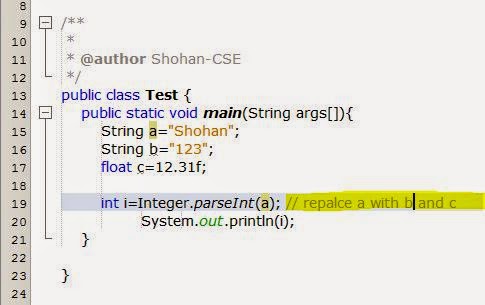The exception handling in java is one
of the powerful mechanism to handle the runtime errors so that
normal flow of the application can be maintained.
Definition : An Exception represent
an error condition that can occur during the normal course of program
execution. When an exception occur the normal sequence of flow is terminated
and the exception-handling routine is executed. When an exception occurs we say
an exception is thrown ,When the matching
exception handling code is executed we say the thrown exception is
caught.
In Other word we can say an exception
handling is a mechanism to handle to run time error of program such as Arithmetic
Error ,IO error etc.
When an exception occurs we say exception is “thrown”
and handling exception is called
“caught” the exception.
Definition 2 : In java, exception is an event that disrupts
the normal flow of the program. It is an object which is thrown at runtime.
Advantage of Exception Handling
The core advantage of exception handling is to maintain the normal flow of the application. Exception normally disrupts the normal flow of the application that is why we use exception handling. Let's take a scenario:
1. statement 1;
2. statement 2;
3. statement 3;
4. statement 4;
5. statement 5; //exception occurs
6. statement 6;
7. statement 7;
8. statement 8;
9. statement 9;
10. statement 10;
1. statement 1;
2. statement 2;
3. statement 3;
4. statement 4;
5. statement 5;//exception occurs
6. statement 6;
7. statement 7;
8. statement 8;
9. statement 9;
10. statement 10;
Suppose there is 10 statements in your program and there occurs an
exception at statement 5, rest of the code will not be executed i.e. statement
6 to 10 will not run. If we perform exception handling, rest of the exception
will be executed. That is why we use exception handling in java.
Types of Exception :
1. Checked Exception
2. Unchecked Exception
A checked Exception is an exception that is checked at
compile time all other exceptions are unchecked exception also called Runtime
exception.
Unchecked exceptions are
not checked at compile-time rather they are checked at Runtime , ArithmeticException, NumberformatException
are two example of Runtime exception.
Some Example of Exception :
a.
ArithmethicException :
Int a=13/0;
b.
NumberFormatException :
**
Understanding parseInt() method:
Instead
of using the data type specific methods such as nextInt, nextDouble,
and
others of the Scanner class, we can input a numerical value in a string format
and
convert it to an appropriate data type by ourselves. For example, we can use
the class method parseInt of the Integer class to convert a string to an
int. Here’s a statement
In
other word parseInt() takes numerical value as an integer and return
integer.
that
converts "123" to an int value 123:
int
num = Integer.parseInt("123");
c. NullPointerException
:
If
we have null value in any variable and if we try to perform any operation by
the variable then it occurs a NullPointerException.
Getting Started In Exception :
try-catch Block :
try and catch block is used to handle
exception. try block is used to enclose the code that might throw an exception. It
must be used within the method.
Java
catch block is used to handle the Exception. It must be used after the
try block only. We can use multiple catch block with a single try.
If
an exception occurs inside the try block then the statements remaining
inside try block is skipped and the execution flow passed to the
matching catch (handler block) block.
Here
is a simple figure it might be helpful.
** keyword : throw and throws.
The “throw” keyword is used to
throw an exception.
We can throw either checked or unchecked exception in
java by throw keyword. The throw keyword is mainly used to throw custom
exception.
Syntax of “throw” : throw < a throwable
object>
Example : throw new myexception(“This is an
Error.”);
As I mentioned before < a throwable object > which
is an instance of Exception Class. When create an instance of the Exception
class we can pass the String that describes the error, the thrown exception is
caught by the corresponding catch block and the error message will be
displayed.
Simple Code :
package exceptionhandeling;
import java.util.*;
public class NewClass3 {
public static void main(String args[]){
Scanner input=new Scanner(System.in);
int age;
println("Enter your Age :
");
try{
age=input.nextInt();
if(age<=0){
throw new
Exception("What the Hell you are Doing !!");
}
if(age>99)
throw new
Exception("Amare Ki Mone hoy ?? ");
}
catch(InputMismatchException
myexception){
input.next();
println("Please Enter
Digit only.");
}
catch(Exception myexception){
println("Error :
"+ myexception.getMessage());
}
}
public static void println(Object n){
System.out.println(n);
}
}
Enough for today. I will try to write more dipper in Exception Handling to
my next article I hope you enjoyed it. May be I made some mistake please let me
know about so that I can improve it.
Author : Md. Shohanur Rahaman






